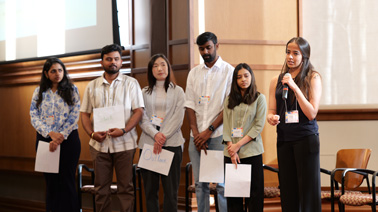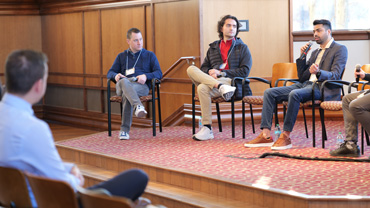
Harshesh Sayani is a self-proclaimed idealist in a tech-heavy world. The second-year Human Computer Interaction/design student seeks to change the world and impact millions.
Last week’s annual HCI/d Connect event at Presidents Hall was another step toward that. It’s an opportunity only the Luddy School of Informatics, Computing, and Engineering and its more than 20-year-old HCI/d program, provides. The program’s 800-plus graduates reflect the benefits.
“You start thinking of the big picture and the accessibility you can provide,” Sayani said. Your thought processes change. Your mindset changes. You learn from professors, colleagues, peers. A lot of things I wasn’t considering before, I am now.”
Sayani was one of more than 70 students, including 14 from the Luddy Indianapolis campus, who participated in HCI/d Connect, which was held in conjunction with IU Career Services. In addition to networking with a panel of HCI/d alumni and tech industry professionals, students also participated in a design competition, addressing the theme, “Fighting Back Against Digital Distraction.”
Sayani was on one of two runner-up teams, joining Atharva Sanjay Sakharkar, Hriishikesh Zope, Tanmayee Pemmaraju and Ananya Singh.
The winning team consisted of Arjun Raghavan, Priyamwada Pandey, Sumedha Kulkarni, Sanika Mehta, Sneha Mali (from Luddy Indianapolis) and Sarvani Polisetty.
Students on the other runner-up team were Naveena Pandiarajan, Kaushik Jayanthi, Aditi Raghav (from Luddy Indianapolis), Jaivrat Saroha, Namrata Shripad Dharmadhikari and Pranit Jena.
Colin Gray, associate professor of Informatics and HCI/d program director, said HCI/d Connect, much like the program itself, is geared for students to build and practice the skills needed to address challenging problems.

Gray said students did a great job addressing distraction, a major issue for technology users. They said the winning teams incorporated creative ways of addressing notification fatigue -- from a playful sponge that talked back and engaged the user in goal setting to a visually-focused vision board to a physical device that encouraged users to work in sprints with fewer distractions.
“The most successful teams were able to not only come up with creative solutions to the prompt,” they said, “but also to effectively communicate the nuance of their design approach and outcomes within the constraints of a three minute presentation.”
Gray added that the alumni and employer panels gave students new ways to think about being career ready for emerging trends in design practices, including considering the increasingly central role of AI, the importance of effectively communicating with and persuading key stakeholders, and showcasing their unique backgrounds and potential to employers.
Pandey, a first-year HCI/d student and winning-team participant, came to Luddy with an architectural design background. She said she was designing for physical spaces in India, but wanted to make a bigger impact. She said the HCI/d program provides invaluable insight and opportunity, as well as the flexibility to tackle multiple research ideas.
“The first week I got here, I realized the practices I had been using were not the right methodology,” she said. “The projects I’m working on here are not something you can do in the main industry. I realized I could implement all these new insights and make something for people, something many people wouldn’t think about. That’s what go me into the program. That’s the flexibility you get here.”
Singh, a first-year HCI/d student who was on a runner-up team, also praised the program’s flexibility. She said she used the event to meet people and work on her networking skills.
“I like the environment with the Luddy program,” she said. “There is no right way. I love the critique sessions. We are humbled about our work. It made me readjust my mentality as a designer.”
Sayani said the HCI/d program offers invaluable research knowledge along with practical project experience.
“I wanted to do something I would like and impact the world,” he said. “I was a senior designer in India, but the impact wasn’t that big. Maybe a few thousands of people were impacted with the designs I was making.
“This program gave me the opportunity to work on things millions are using. I’m able to make an impact on millions. That’s what I was looking for.”
Opportunity came with an internship at SeatGeek, a mobile-focused ticket platform for buying and selling tickets for live sports, concerts and theater events.
“Something I designed was live on their home page,” Sayani said. “It got millions of views. That encouraged me to work harder. It encourages you to go one step further and impact more people. It helps you understand the things you can do.
“I’m grateful for everything I’ve gotten from the HCI/d program -- the real world experience and all the technical knowledge.”
Alexis King who is in her first year at HCI/d, was drawn by the Luddy program’s collaboration opportunities and the chance to work with people from different backgrounds to “create something that is special to each business or person or user.”
As far as the design challenge, King said, “It wasn’t about winning. It was about working together and showing the best we can.” She added she was excited to collaborate with students from Luddy Indianapolis campus.
King hopes to start a career as a UX researcher in a consulting company.
“I want to get my hands on different projects and dip my toes into different areas. The one thing I love about HCI/d is you can get a little bit of everything -- business, psychology, marketing.”
Snehashish De, a second-year HCI/d student, said he was drawn to the program because it goes beyond design to involve user needs and values.
“You try to make something that improves the quality of life,” he said. By contribution something bigger than you, it has an impact on a wider scale. That intrigues me.”
So did the design challenge.
“Something that we build in HCI/d is storytelling,” De said. “When it’s a competition, you want to win, but you also to get to learn a lot from other story-telling styles. It was a good learning experience.”
Learning from the panelists was also a highlight.
“We got to meet and talk to them, understand their expectations, what they think about design and what their values are,” De said.
Professional panelists were Samantha Merritt, senior director at Eli Lilly; Derren Hermann, director at Nationwide Mutual Insurance; Ethan Latham, a designer at Uline; and Tori Clifford, program director at Brooksource. The panelists provided guidance on the interview process, encouraged students to practice their communication skills, and addressed new challenges that face HCI designers as it relates to AI.

Alumni panelists were Isaac Gutjahr, UX researcher at Zebra Technologies; Sohile Ali, Indiana University user experience designer; and Nikith Joshua Dsouza, senior product designer at Medidata Solutions. The panelists emphasized the importance for current students to take advantage of the HCI/d studio, getting out of their comfort zones, and build skills in advocating for good UX and design practices.
As for students concerned about the job market, Gray said, “This is an interesting time for employment in the U.S. You all have a lot of skills you can bring to the table. It’s important to identify, not only the superpowers that you have, but also the superpowers others have.”
Gray said HCI/d Connect’s goal was not to necessarily find an internship or job for each student as much as provide opportunities to engage with Luddy HCI/d alumni and employers.
“It’s about networking and students sharing their skills and learning about what skills are expected of them,” they said.
And one final thing:
“Have a lot of fun.”

